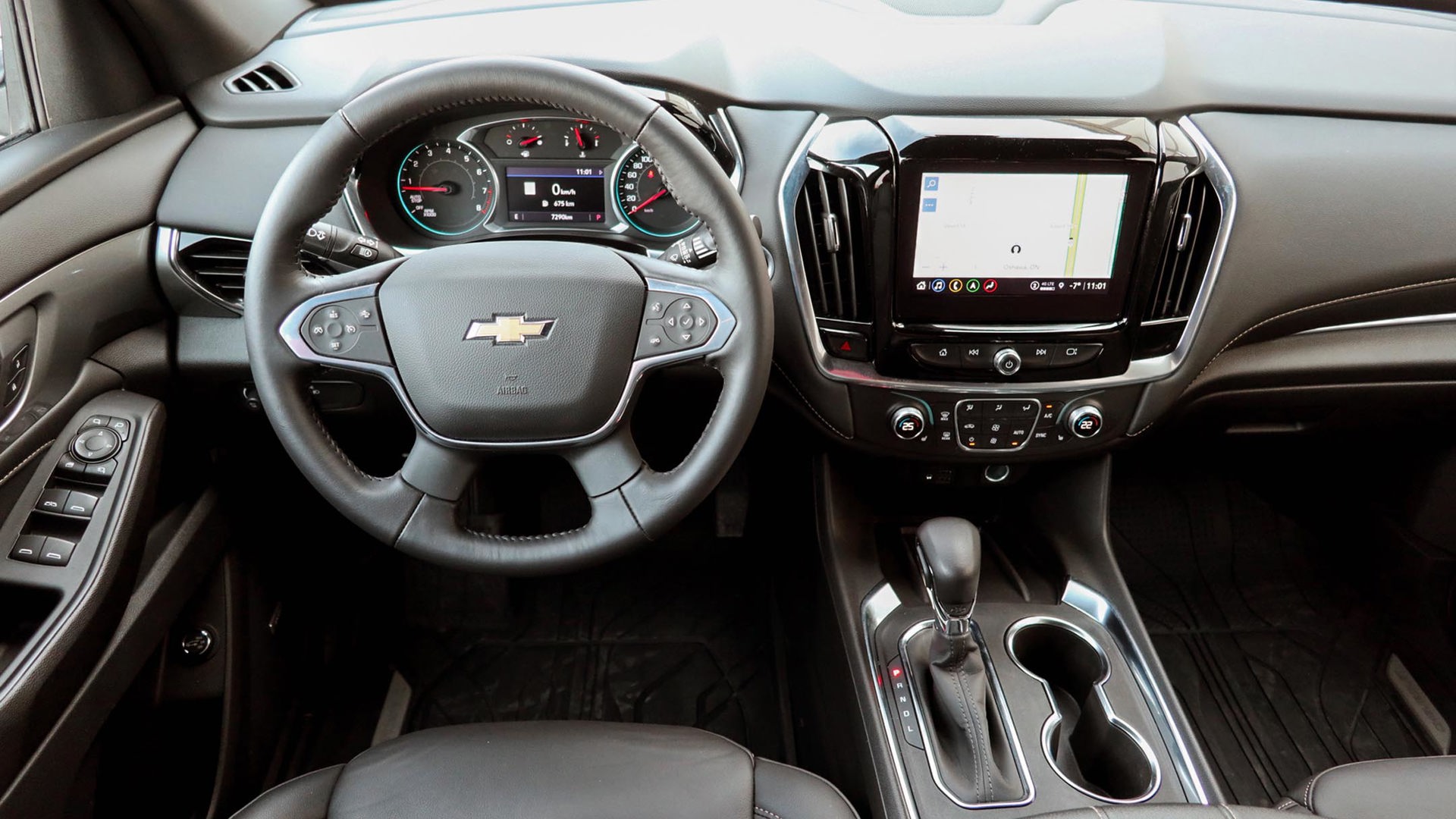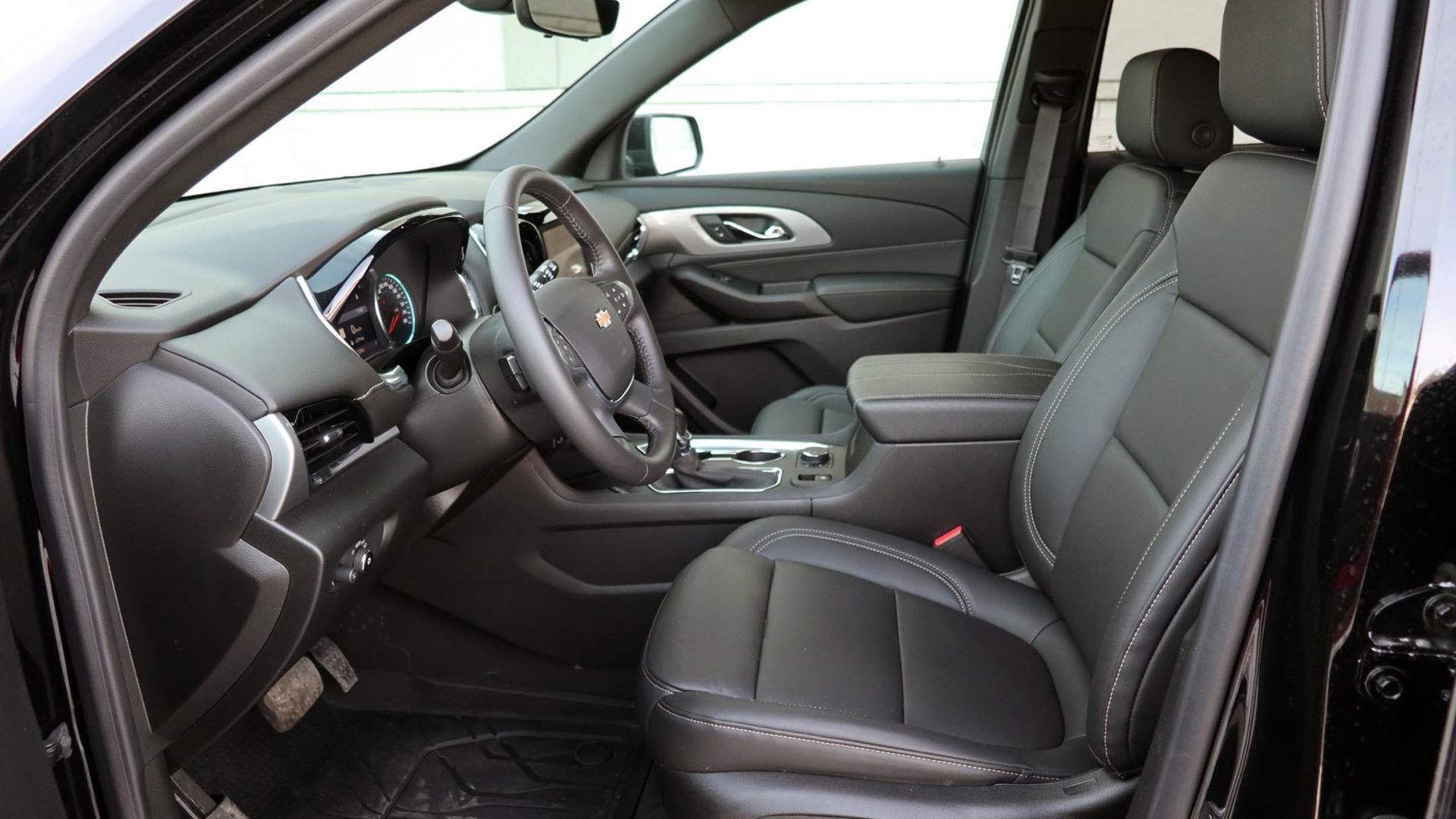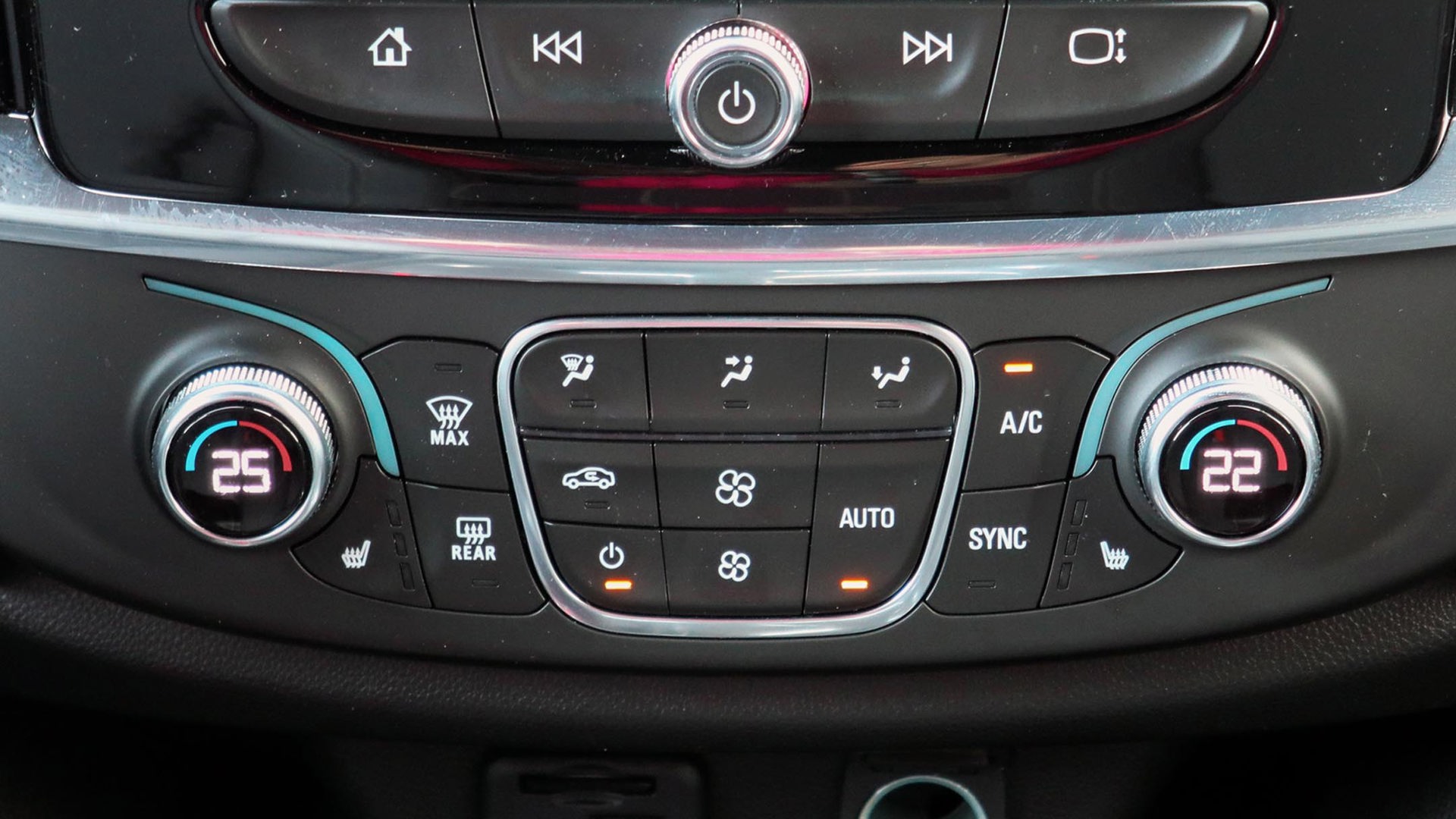 AutoTrader SCORE
AutoTrader SCORE
-
STYLING9/10
-
Safety8/10
-
PRACTICALITY8/10
-
USER-FRIENDLINESS8/10
-
FEATURES8/10
-
POWER8/10
-
COMFORT8/10
-
DRIVING FEEL8/10
-
FUEL ECONOMY7/10
-
VALUE7/10
Having usurped the minivan as the family-hauler of choice, the three-row SUV segment has become very crowded with good choices.
In the case of the 2022 Chevrolet Traverse, it offers more third-row space than many of its competitors, making it as close to a minivan alternative as possible. With standard all-wheel drive (AWD) in Canada, the Traverse starts at $41,843 for the LS; that’s before tax but including a non-negotiable delivery charge of $1,900. I drove the LT True North at $51,198. My tester was further dished up with extra-charge paint and wheels that brought it to $55,243 before tax.
Styling: 9/10
The Traverse is a well-proportioned and good-looking vehicle. It gets a mild styling refresh for 2022, with a new fascia, roof rails, and taillights. The cabin styling is simple, and I like that the theme carries over into the controls, but when you start getting past the $50,000 mark, the materials and design can look too plain for the price.
My tester’s options were its coat of Mosaic Black Metallic paint ($495) and 20-inch chrome wheels ($3,455), plus another $95 for matching chrome locks to keep them on my vehicle. The wheels are little more than a shinier version of the True North package’s standard alloys. I’d rather have the smaller 18-inch wheels that come on the LT when I’m buying replacement or winter tires.
Safety: 8/10
The Traverse gets a top “Good” rating in crash testing from the not-for-profit Insurance Institute for Highway Safety (IIHS), but only rates “Acceptable” for ease of use on its child seat mounts. The United States National Highway Traffic Safety Administration (NHTSA) hasn’t tested the 2022 version with its new front end, but the 2021 Traverse got the top five stars for crash tests.
The LT comes standard with driver assist features including emergency front braking with pedestrian detection, blind-spot monitoring with rear cross-traffic alert, lane-keeping assist, and the rearview camera that’s mandatory on all new vehicles. The True North then adds enhanced emergency braking at highway speeds, 360-degree camera, and a rearview mirror that can be used conventionally or flipped to provide a video view of what’s behind. It takes a bit to get used to it, but because the camera is at the back, your view won’t be blocked by your third-row passengers’ heads.
Most of the assist systems worked well, but the emergency front braking could sometimes be a bit too keen. A couple of times it hit the brakes when it wasn’t necessary; I wasn’t close to another vehicle or closing the gap on one.
Features: 8/10
The True North builds on the LT that includes a height-programmable power tailgate, power driver’s seat, tri-zone automatic climate control, cloth upholstery, remote starter, and eight-inch infotainment with wireless Apple CarPlay and Android Auto. From there, the True North adds power-folding mirrors, a dual-pane sunroof, 120-volt power outlet, power passenger seat, premium stereo, navigation, surround-view camera, and leather-trimmed seats. And the True North really is about driving in Canada, since its standard features also include a rubber cargo tray and floor liners for all three rows. In jest, I note that the True North can’t be ordered with an upholstery colour combination from the upper trims – jet black and maple, and how do you get any more Canadian than that?
User Friendliness: 8.5/10
The Traverse doesn’t look high-tech, with its cluster of centre-stack controls and especially the rubber-covered buttons on the steering wheel, but that simplicity is form over function. The controls are intuitive and easy to use, including the infotainment screen, which reduces distraction.
Visibility is good, and it’s easy to get in and out of the first and second rows. Three-row seating is always a compromise, but the rear doors open wide and the second-row seats both slide and flip forward. It’s easier to get back there than in many of the Traverse’s competitors. The tailgate’s opening goes right down to the bumper, so you don’t have to lift items too far up when loading cargo.
Practicality: 8/10
Three-row SUVs still aren’t as practical overall as minivans, but the Traverse does a pretty good job. Seven-passenger seating is standard in True North, but you can opt for a second-row bench seat to handle eight occupants total. Small-item storage is good, and there’s a hidden compartment behind the infotainment screen.
Among three-row competitors such as the Ford Explorer, Kia Telluride, and Subaru Ascent, the Traverse has the most front-seat headroom, and the Explorer beats it for third-row headroom by only 18 mm (0.7 in). All three have a bit more front- and second-row legroom, but the Traverse defeats all with a relatively generous 851 mm (33.5 in) of third-row legroom – 54 mm (2.1 in) more than the Telluride, the tightest of the three. The Traverse also has more cargo space than those three with the seats up or folded.
Comfort: 8/10
The Traverse’s front and second-row seats are supportive, and you and your passengers are set for a longer drive. The third-row seats are on a riser, so only the tallest will have their chins on their knees, as is the case with many three-row models. But those seats are flat and hard, and best for short trips only.
The True North comes with leather upholstery, and normally these seats are heated, as is the steering wheel. However, pandemic-related chip supply issues came into play, and those features weren’t operable on my vehicle. Buyers get a discount when they purchase, and dealers then retrofit them to work when microchips become available.
Power: 8/10
All Traverse trims are powered by a 3.6L V6 engine making 310 hp and 266 lb-ft of torque that’s mated to a nine-speed automatic transmission and all-wheel drive. That’s more horsepower than the Telluride’s V6, or the turbocharged four-cylinder in the Subaru Ascent. It’s also more than the 300 hp in the Explorer’s base 2.3L turbocharged four-cylinder, although the Ford can be had with a turbo V6 that makes up to 400 hp.
I’ve driven the 3.6L in the smaller Blazer, where the performance is punchier, but it’s still a valid engine for the larger, heavier Traverse. The engine can get a bit noisy on hard acceleration, but it easily handles highway passing. The transmission shifts smoothly, and the ride is well-balanced and comfortable. The Traverse can tow up to 2,268 kg (5,000 lb), on par with the Telluride, but short of the Explorer’s maximum of 2,404 kg (5,300 lb) to 2,540 kg (5,600 lb), depending on the engine selected. The True North includes multiple camera views including one on the hitch, to help you guide it to your trailer.
Driving Feel: 8/10
The Traverse is a big vehicle, and you notice that when parking, but it has responsive handling and a smooth ride. It’s well-planted around corners, and body roll is controlled. It does what it’s supposed to do, aimed at a core audience that prefers a quiet, comfortable ride and isn’t concerned with sportiness.
The AWD system primarily drives the front wheels, but sends power to the rear as needed if it detects a loss of traction. The Traverse is also one of the few AWD vehicles to offer the driver the ability to turn the system on and off, though I don’t see a great advantage to it. The front-wheel drive fuel savings would be minimal, and if you forget to switch over on a rainy or snowy day, you won’t have the benefit of the all-wheel traction if you need it.
Fuel Economy: 7/10
The Traverse is officially rated by Natural Resources Canada (NRCan) at 13.6 L/100 km in the city, 9.6 on the highway, and 11.8 in combined driving. In my week with it, I averaged 12.6 L/100 km. That’s not terribly out of line in the three-row segment, but some competitors do better. The Ford Explorer with turbocharged four-cylinder is rated at 10.3 L/100 km in combined driving, although its V6 matches the Traverse’s V6 at 11.8. The Subaru Ascent, a slightly smaller vehicle but with full-time all-wheel drive, rates at 10.5 L/100 km.
Value: 7/10
The Traverse ranges from $41,843 to $62,643, including the delivery charge of $1,900. It offers a number of features, as well as more third-row and cargo space than many competitors, and buyers can choose from a variety of price points. However, the interior doesn’t always match the tag on upper trims, and perceived value is part of the equation.
By comparison, the Explorer begins at $48,694 (all prices with delivery) and goes to $68,404 for the top Platinum, while the Telluride ranges from $48,890 to $58,590. Subaru’s Ascent starts at $39,170 and goes to $53,670.
The Verdict
There are a great many choices in this segment, and all bring something to it. The 2022 Chevrolet Traverse doesn’t deliver the knockout among them, but I like it for its comfortable ride, simple controls, and lots of cargo space, along with the True North’s winter-ready interior protection. If you have a lot of people to move, it should be a contender.
| Engine Displacement | 3.6L |
|---|---|
| Engine Cylinders | V6 |
| Peak Horsepower | 310 hp @ 6,800 rpm |
| Peak Torque | 266 lb-ft @ 2,800 rpm |
| Fuel Economy | 13.6 / 9.6 / 11.8 L/100 km cty/hwy/cmb |
| Cargo Space | 652 / 1,636 / 2,781 L behind 3rd/2nd/1st row |
| Model Tested | 2022 Chevrolet Traverse LT True North |
| Base Price | $49,298 |
| A/C Tax | $100 |
| Destination Fee | $1,900 |
| Price as Tested | $55,343 |
|
Optional Equipment
$4,045 – 20-inch Chrome Aluminum Wheels, $3,455; Mosaic Black Metallic Paint, $495; Chrome Wheel Locks, $95
|
|












































